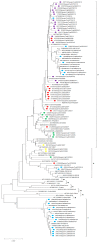Epidemiology of Echovirus 30 Infections Detected in a University Hospital in Catalonia, Spain, in 1995-2020
- PMID: 35336167
- PMCID: PMC8955149
- DOI: 10.3390/microorganisms10030592
Epidemiology of Echovirus 30 Infections Detected in a University Hospital in Catalonia, Spain, in 1995-2020
Abstract
There is a growing interest in echovirus 30 (E30), an enterovirus responsible for neurological disease and hospitalization. There are multiple studies of outbreaks, but few that study the epidemiology over long periods of time. Our study aims to describe the clinical, epidemiological and microbiological characteristics of a series of E30 infections detected over 26 years. Data were retrospectively collected from a database of all enterovirus infections identified in our laboratory. They were detected by viral isolation or nucleic acid detection in patients presenting with respiratory or neurological infections, rash, sepsis-like syndrome, or gastroenteritis. Enterovirus genotyping was performed by amplification of the VP1 gene using RT-nested PCR, followed by sequencing and BLAST analysis. Of the 2402 enterovirus infections detected, 1619 were linked to at least one genotype and 173 were caused by E30. Clinical information was available for 158 (91.3%) patients. E30 was associated with neurological infection in 107 (67.8%) cases and it was detected almost every year. Phylogenetic analysis was performed with 67 sequences. We observed that E30 strains circulating in Catalonia from 1996 to 2016 belong to two lineages (E and F), although the majority cluster was in F. In 2018, lineage I emerged as the dominant lineage.
Keywords: central nervous system; cerebrospinal fluid; echovirus 30; enteroviruses; epidemiology; phylogenetic analysis.
Conflict of interest statement
The authors declare no conflict of interest.
Figures



References
-
- Internationall Committee on Taxonomy of Viruses ICTV Picornaviridae. [(accessed on 15 November 2021)]. Available online: https://talk.ictvonline.org/ictv-reports/ictv_online_report/positive-sen....
-
- Liu W., Wu S., Xiong Y., Li T., Wen Z., Yan M., Qin K., Liu Y., Wu J. Co-Circulation and Genomic Recombination of Coxsackievirus A16 and Enterovirus 71 during a Large Outbreak of Hand, Foot, and Mouth Disease in Central China. PLoS ONE. 2014;9:e96051. doi: 10.1371/journal.pone.0096051. - DOI - PMC - PubMed
LinkOut - more resources
Full Text Sources
Research Materials

